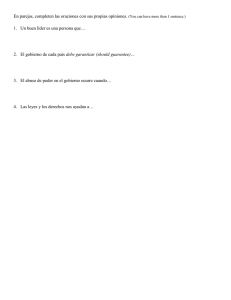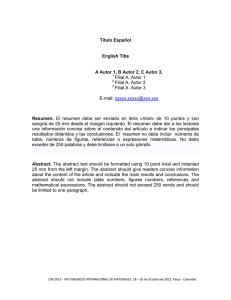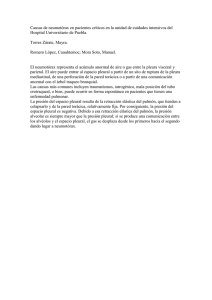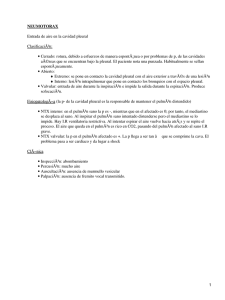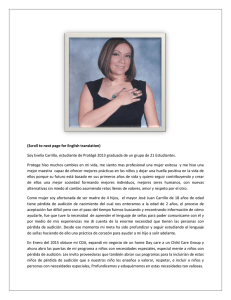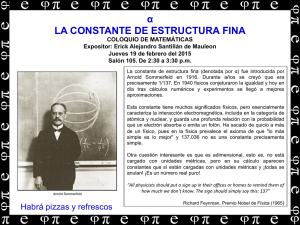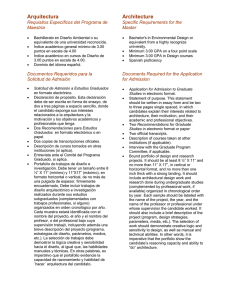Tratamiento Tratamiento Médico del Empiema Médico del Empiema
Anuncio
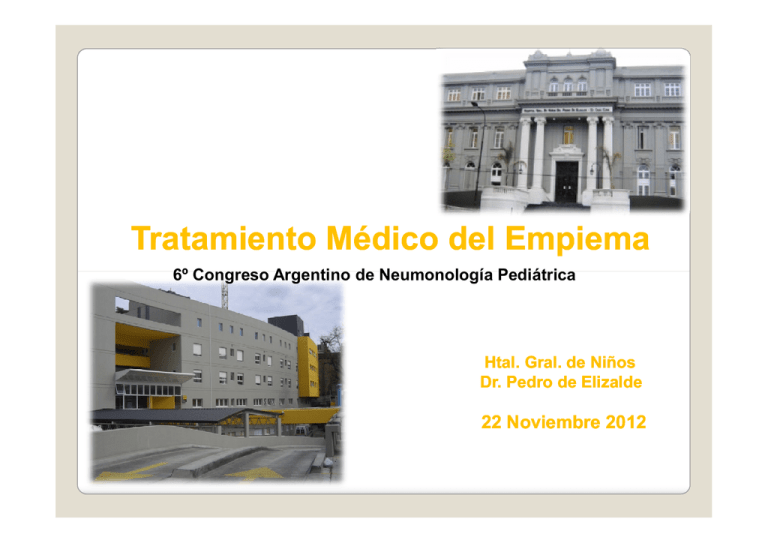
Tratamiento Médico del Empiema 6º Congreso Argentino de Neumonología Pediátrica Htal. Gral. de Niños Dr. Pedro de Elizalde 22 Noviembre 2012 Comisión de Empiema – 1914 Mortalidad 70 % Empyema in children; a twenty-five-year study B Lionakis, S Gray, J Skandalakis J Pediatr 53(6):719-25 (1958) Parece probable que este estudio abarque el período de la extinción práctica del empiema como una enfermedad importante De 210 niños ingresados con derrame pleural, demostraron que el 68% de los derrames son paraneumónicos y el 32% empiema en USA Hardie W, Bokulic R, Garcia VF, et al. Pneumococcal pleural empyemas in children. Clin Infect Dis. Jun 1996;22(6):1057-63 Empiema se informó en aproximadamente 0.6-2% de los niños con neumonía bacteriana Chonmaitree T, Powell KR. Parapneumonic pleural effusion and empyema in children. Review of a 19-year experience, 1962-1980. Clin Pediatr (Phila). Jun 1983;22(6):414-9 Mocelin HT, Fischer GB. Epidemiology, presentation and treatment of pleural effusion.Paediatr Respir Rev. Dec 2002;3(4):292 El 2.4% tuvieron neumonia complicada con empiema Community-acquired pneumonia (CAP) in children in Oslo, Norway Senstad et al Acta Paediatrica Volume 98, Issue 2, pages 332–336, February 2009 The Management of Community-Acquired Pneumonia in Infants and Children Older Than 3 Months of Age: Clinical Practice Guidelines by the Pediatric Infectious Diseases Society and the Infectious Diseases Society of America (IDSA) John S. Bradley,1,a Carrie L. Byington,2,a Samir S. Shah,3,a Brian Alverson,4 Edward R. Carter,5 Christopher Harrison,6 Sheldon L. Kaplan,7 Sharon E. Mace,8 George H. McCracken Jr,9 Matthew R. Moore,10 Shawn D. St Peter,11 Jana A. Stockwell,12 and Jack T. Swanson13 Clinical Infectious Diseases Advance Access published August 301, 2011 Un estudio prospectivo en niños realizado en Europa y América sobre neumonía adquirida de la comunidad demostró que el empiema se presentó entre un 2% y un 12% Boletín oficial 2010 Ministerio de Salud, Argentina Total 37.602 Neumonías en niños Estimación de Neumonía complicada 2 % al 6 % 12 % La tasa de mortalidad fue de 3.68 % 752 – 2256 pac. 4512 pac. 1.387 niños fallecidos por esta enfermedad Treatment of Complicated Parapneumonic Pleural Effusion With Streptokinase Intrapleural in Children* Chih-Ta Yao 2004 Surgery, No. of patients/total 2 / 20 Drainage, Fibrinolytics, or Surgery: A Comparison of Treatment Options in Pediatric Empyema Robert L. Gates, Mark Hogan, Samuel Weinstein, and Marjorie J. Arca Columbus, Ohio Journal of Pediatric Surgery, Vol 39, No 11 (November), 2004: pp 1638-1642 Estudio con 52 pac. Treatment of encapsulated pleural effusions in children: a prospective trial. Kobr J, Pizingerova K, Sasek L, Fremuth J, Siala K, Racek J. Pediatr Int. 2010 Jun;52(3):453-8. Nov 16. Prospective study, 76 consecutive children (average age 5.0 +/- 4.14 years) Neumonía Complicada con Empiema Período 11 años 2001 / 2012 905 pac Primer Período Septiembre 2001 / Agosto 2005 AÑO Empiemas VT- VATS STK 2005 89 14 49 2004 76 6 27 2003 62 15 15 2002 36 2 12 Total 103 casos Clínicos Cirujanos STK Anestesistas Distribución por sexos 600 500 400 300 200 561 344 100 0 Masculino Femenino 62 % 38 % n = 905 Localización 600 500 400 300 200 100 534 371 0 Derecho 59 % Izquierdo 41 % n = 905 Procedencia en % 60 50 40 30 20 10 0 CABA 46 % Pcia. Bs. As. 52 % n = 905 Otros 2% CABA 70 60 50 40 30 20 10 561 344 0 Derivados Propios 62 % 38 % n = 905 Edad 60 50,5 50 40 34,5 30 20 10 9,3 5,7 0 <1 1a5 6 a 10 84 457 312 n =905 > 10 52 Edad 140 120 100 80 60 40 20 0 1 2 3 4 5 6 7 8 9 10 11 12 13 14 15 Síntomas 100% 90% 80% 70% 60% 50% 40% 30% 20% 10% 0% Radiografía de tórax 100 % de los casos de Frente Limitaciones: No es posible diferenciar el líquido de engrosamiento pleural No es útil para estadificar la enfermedad Ecografía -Tomografía Ecografía pleural Se realizó en todos los niños Es la mejor técnica para diferenciar líquido pleural y consolidación Estima tamaño, complejidad y grado del derrame Demuestra presencia de septos de fibrina y Guía colocación de drenaje torácico. TAC No la hemos utilizado de rutina Indicaciones Evolución desfavorable Hemitorax opaco Evaluar cirugía Empiema bloqueado Diferenciar compromiso pleural – parenquimatoso - tumoral Clasificamos en: Grupo 1 (G I): pacientes con SPP que consultaron con <7 días de evolución. Grupo 2 (G II): pacientes con SPP que consultaron o fueron derivados de otros centros entre los 8 y 14 días de evolución. Grupo 3 (G III): pacientes con SPP con >15 días de evolución Total n=905 (2001 / 2012) GI G II G III 131 475 293 14.47 % 52.48 % 32.37 % Correlación entre la ecografía y la imagen real de los tabiques Opciones quirúrgicas terapéuticas Toracocentesis seriadas Tubos de drenaje comunes Colocación de pequeños tubos (pig tail) Video Toracoscopía VATS Toracotomía Decorticación Fibrinoliticos Video - toracoscopía Cirugía Torácica Video Asistida - VATS Cirugía Torácica Video Asistida - VATS Toracotomía Decorticación STK Líquido pleural Aspecto purulento Sólo Bacteriología Aspecto es citrino Bacteriología + físicoquímico Sensibilidad Especificidad Ph 68 95 Glucosa 75 95 LDH 77 65 Cultivo del líquido pleural Hemocultivo GI G II G III Líquido Pleural Derivados 23 % 18 % 6 % 35 % - 17 % 21 % - 11 % 3%- 0% Streptococcus pneumoniae Haemophilus influenzae tipo b Micoplasma pneumoniae Streptococcus grupo B Staphilcoccus aureus MR Chlamydia trachomatis Streptococcus pneumoniae resistente Otros Total n=905 (2001 / 2012) GI G II G III 14.47 % 52.48 % 32.37 % Registro de datos Protocolos pre impresos que incluían: Datos del paciente: nombre, edad, sexo Fecha de ingreso y egreso Días de evolución Sintomatología Exámenes complementarios : oImágenes: Rx Ecografía TAC oLaboratorio: Hemograma Cultivos oTratamiento: ATB, Oxigenoterapia Toracocentesis: Material obtenido: características, citoquímico y cultivo volumen, drenaje, calibre STK: dosis, días, débito Clínica General Retiro drenaje Alta: estudios al alta Empiema: Inclusión Protocolo STK Debe cumplir con los siguientes requisitos Enfermedad febril con la consolidación neumónica en el inicio Líquido en el espacio pleural en la radiografía de tórax y ecografía Líquido pleural turbio con células de pus y / o loculación en la ecografía Drenaje Drenaje tradicional Drenaje pleural “pig tail” Menos dolor, mejor tolerancia Chest 1998; 114:1116-1121 Arch Dis Child 2002; 87: 331-332 Thorax 2002; 57: 343-347 Ped Pulm 2005;39: 127-134 Neumonía Complicada con Empiema Segundo Período Septiembre 2005 / Agosto 2012 642 7 Años AÑO N° C /Fístula 2012 91 6 85 2011 81 7 74 2010 101 9 92 2009 85 5 80 2008 96 5 91 2007 90 7 83 2006 98 9 89 2005 89 - 14 49 2004 76 - 6 27 2003 62 - 15 15 2002 36 - 2 12 Total 905 VT-VATS STK 697 594 De un total de n=642 utilizamos STK en 594 (n=48 con fístula) 92.52 % Total STK n=594 (2005 – 2012) GI G II G III 76 340 178 12.79 % 57.23 % 29.96 % Se incluyeron 1 1 1 35 días 38 días 43 días Se excluyeron pacientes drenados con más de 45 días de evolución y aquellos con fístula alvéolo pleural STK Dosis: 10000 UI / Kg / d hasta un máximo de 250000 UI Presentación 250000 UI 750000 UI 1500000 UI Costo 2300 $ á 3000 $ (Htal. – Particular) Preparación Dilución 15 cc = 100000 UI / ml Conservación Jeringas prellenadas de 100000 UI c/u En freezer = 6 meses STK: Estabilidad de las diluciones conservadas a -25° C Pigliapoco V, Bartoletti S, Giambini D, Balbarysky J. Aba Vol 74 2010 Modo de empleo Se instila STK con 50 (100) cc de Solución fisiológica Clampeo del drenaje durante 2 – 4 Hs cada 24 hs Cantidad de líquido obtenido Con débito positivo se administra STK (100 – 550 cc) Suspende STK y Retiro del drenaje débito es nulo menor 40 cc en 24 Hs (1 ml/ Kg) citrino Días de uso de STK n=594 (2005 – 2012) 1 día 2 días 3 días 4 días 5 días 6 días 7 días 8 días 18 61 217 166 102 25 5 0 3.04 % 10.26 % 36.53 % 27.94 % 17.17 % 4.20 % 0.86 % 0.00 % GI G II G III 76 340 178 13.30 % 49.83 % 77.77 % 94.94 % 12.79 % 57.23 % 29.96 % Efectos adversos fiebre = ó < 38.2 ° C Difícil de valorar urticaria, rash 3 0.59 % dolor torácico 3 0.59 % sangrado leve 12 2.35 % Alteración de la coagulación TOTAL 0 3.53 % (Se altera la coagulación en pacientes tratados con STK intrapleural?, Estudio en 100 pac consecutivos 2007-2008) Dra Bellapianta y col. Aba Vol 72 2008 Días de drenaje GI G II G III 1-2d 2-5d 4-8d Días de internación (Dependió de la duración de la duración del trat, Atb EV) GI G II G III 2-4d 4-7d 7 -14 d Neumonía necrotizante Atb 29 días (n=40) Indicaciones de cirugía Persistencia de fiebre (sepsis) No mejoría de clínica respiratoria Fracaso del tratamiento Aparición de otras complicaciones n=594 Cirugía 12 2.02 % Neumonía necrotizante Atb 29 días (16 / 40) Mortalidad 5 de 905 pac 0.55 % Ninguno tratado con STK 4 en el primer período GIII 51-55-60-88 días 1 en el segundo GIII > 50 días PIVOT Trial Pneumonia Intravenous Versus Oral Treatment Multi-Centre Randomised Controlled Trial Of Oral Versus Intravenous Treatment For Community Acquired Pneumonia In Children M Atkinson, M Lakhanpaul, A Smyth, H Vyas, V Weston, J Sithole, V Owen, K Halliday, H Sammons, J Crane, N Guntupalli, L Walton, T Ninan, A Morjaria, T Stephenson Department of Child Health, University of Nottingham THORAX 2007;62:1102 Se sugiere 10 a 14 días para neumococo y 21 días para S. aureus Cuando tenga tolerancia por vía oral el antibiótico podrá administrarse por ésta vía EMPIEMA PLEURAL Sociedad Argentina de Pediatría Dr. Hugo Paganini 2010 TAIS Tratamiento Ambulatorio de Infecciones Severas Conclusiones En nuestra experiencia la STK es útil, efectiva, de bajo costo y de manejo sencillo, sin requerimiento de gran infraestructura La estancia hospitalaria es corta Presenta un índice de complicaciones bajo, ninguna de gravedad evidenciada por nosotros Alta tasa de éxito terapéutico sin la necesidad de procedimientos adicionales quirúrgicos Duración de la fiebre antes de la admisión 4 - 25 d 11.8 d Duración de la fiebre después de la colocación del drenaje 2–6 d 3.1 d Neumonía necrotizante Atb 29.4 días (n=40) La evidencia sobre la cual basar las recomendaciones es pobre / ausente Los datos del adulto no son trasladables Los niños con empiema tienen casi siempre buenos resultados sea cual sea el manejo En nuestra experiencia la STK en útil, efectiva, de bajo costo y de manejo sencillo la estancia hospitalaria es corta y con un índice de complicaciones menores y muy bajo 3.59 % (rash, dolor y sangrado leve) y con una alta tasa de éxitos. BTS guidelines for the management of pleural infection in children I M Balfour-Lynn, E Abrahamson, G Cohen, J Hartley, S King, D Parikh, D Spencer, A H Thomson, D Urquhart, on behalf of the Paediatric Pleural Diseases Subcommittee of the BTS Standards of Care Committee Thorax 2005;60(Suppl I):i1–i21. doi: 10.1136/thx.2004.030676 Postero-anterior or antero-posterior radiographs should be taken, there is no role for a routine lateral radiograph. [D] Ultrasound must be used to confirm the presence of a pleural fluid collection. [D] Chest CT scan should not be performed routinely. [D] Diagnostic imaging If GA is not being used, IV sedation should only be given by those trained in the use of conscious sedation, airway management & resuscitation of children, using full monitoring equipment. [D] Since there is no evidence that large bore chest drains confer any advantage, small drains (including pigtail catheters) should be used whenever possible to minimise patient discomfort. [C] Ultrasound should be used to guide thoracocentesis or drain placement. [C] Chest drains Intrapleural fibrinolytics shorten hospital stay and are recommended for any complicated parapneumonic effusion (thick fluid with loculations) or empyema (overt pus). [B] Streptokinase should be given daily for 3 days using 10,000 /Kg units in 40 mls 0.9% saline for children aged 1 year or above. [B] Thomson et al Thorax 2009;57 343-7 Intrapleural fibrinolytics Patients should be considered for surgical treatment if they have persisting sepsis in association with a persistent pleural collection, despite chest tube drainage and antibiotics. [D] Organised empyema in asymptomatic child requires formal thoracotomy and decortication. [D] Surgery Estancia hospitalaria entre 7.2 y 9.4 días Algorithm for the management of pleural infection in children. Balfour-Lynn I M et al. Thorax 2010;60:i1-i21 ©2010 by BMJ Publishing Group Ltd and British Thoracic Society Chest drains: ongoing management See the section below on the use of fibrinolytic therapy. Good analgesia is extremely important. Children should receive regular paracetamol and NSAIDs; additional oral analgesia and/or morphine infusion may be necessary in some children. Children with chest drains should only be managed on wards by staff trained in chest drain management. A clamped drain should be immediately unclamped and medical advice sought if a child has any unexplained deterioration, becomes breathless or has chest pain. If there is a sudden cessation of fluid drainage, the drain should be checked for obstruction (blockage or kinking); the drain may need to be manipulated or flushed. If there is still significant remaining pleural fluid, and a drain is not draining, consider replacing it. Consider obtaining further imaging (initially CXR and then ultrasound) if there is no clinical improvement and / or failure to drain the effusion. CT may be sometimes be useful – discuss with radiology and the surgical / respiratory team. Consider removing a chest drain when: drainage is minimal (e.g. less than 30 mls per 24 hours) and there has been significant clinical progress alongside some radiological improvement. Request a CXR approximately 4 hours after chest drain removal (see separate chest drain guidelines). A bubbling chest drain should prompt the consideration of a bronchopleural fistula and discussion with the surgical team. Never clamp a bubbling chest drain. 2. Intrapleural fibrinolytic therapy (see separate Urokinase administration guidelines) Intrapleural fibrinolytic therapy shortens hospital stay and should be used for all cases of parapneumonic effusion or empyema given intercostal tube drainage. Further surgical intervention (thoracotomy or VATS) Failure of chest tube drainage, antibiotics, and fibrinolytic therapy should prompt early discussion with the surgical team. Children should be considered for surgical intervention if they have persisting respiratory distress, fever or sepsis in association with a persistent pleural collection. Video-assisted thoracoscopic surgery (VATS) may be an appropriate alternative to thoracotomy. Early VATS, as a primary procedure, does not appear to offer benefit over a chest drain and urokinase, but is routinely used in some centres and in the US. Fibrinolytic therapy is usually not used following VATS or thoracotomy. Recovery can be rapid following thoracotomy; surgery may be an appropriate primary procedure in some children with a complex empyema, i.e. when there are extensive loculations, a thick pleural rind and severe lung entrapment in a sick child. A lung abscess coexisting with an empyema does not usually require surgical drainage; chest CT is appropriate imaging when an abscess is suspected. Abstracted bullet points Clinical picture N All children with parapneumonic effusion or empyema should be admitted to hospital. [D] N If a child remains pyrexial or unwell 48 hours after admission for pneumonia, parapneumonic effusion/empyema must be excluded. [D] Diagnostic imaging N Posteroanterior or anteroposterior radiographs should be taken; there is no role for a routine lateral radiograph. [D] N Ultrasound must be used to confirm the presence of a pleural fluid collection. [D] N Ultrasound should be used to guide thoracocentesis or drain placement. [C] N Chest CT scans should not be performed routinely. [D] Diagnostic microbiology N Blood cultures should be performed in all patients with parapneumonic effusion. [D] N When available, sputum should be sent for bacterial culture. [D] Diagnostic analysis of pleural fluid N Pleural fluid must be sent for microbiological analysis including Gram stain and bacterial culture. [C] N Aspirated pleural fluid should be sent for differential cell count. [D] N Tuberculosis and malignancy must be excluded in the presence of pleural lymphocytosis. [C] N If there is any indication the effusion is not secondary to infection, consider an initial small volume diagnostic tap for cytological analysis, avoiding general anaesthesia/sedation whenever possible. [D] N Biochemical analysis of pleural fluid is unnecessary in the management of uncomplicated parapneumonic effusions/ empyema. [D] Diagnostic bronchoscopy N There is no indication for flexible bronchoscopy and it is not routinely recommended. [D] Referral to tertiary centre N A respiratory paediatrician should be involved early in the care of all patients requiring chest tube drainage for a pleural infection. [D] Conservative management (antibiotics ¡ simple drainage) N Effusions which are enlarging and/or compromising respiratory function should not be managed by antibiotics alone. [D] N Give consideration to early active treatment as conservative treatment results in prolonged duration of illness and hospital stay. [D] Repeated thoracocentesis N If a child has significant pleural infection, a drain should be inserted at the outset and repeated taps are not recommended. [D] Antibiotics N All cases should be treated with intravenous antibiotics and must include cover for Streptococcus pneumoniae. [D] N Broader spectrum cover is required for hospital acquired infections, as well as those secondary to surgery, trauma, and aspiration. [D] N Where possible, antibiotic choice should be guided by microbiology results. [B] N Oral antibiotics should be given at discharge for 1–4 weeks, but longer if there is residual disease. [D] Chest drains N Chest drains should be inserted by adequately trained personnel to reduce the risk of complications. [C] N A suitable assistant and trained nurse must be available. [D] N Routine measurement of the platelet count and clotting studies are only recommended in patients with known risk factors. [D] N Where possible, any coagulopathy or platelet defect should be corrected before chest drain insertion. [D] N Ultrasound should be used to guide thoracocentesis or drain placement. [C] N If general anaesthesia is not being used, intravenous sedation should only be given by those trained in the use of conscious sedation, airway management and resuscitation of children, using full monitoring equipment. [D] N Small bore percutaneous drains should be inserted at the optimum site suggested by chest ultrasound. [C] N Large bore surgical drains should also be inserted at the optimum site suggested by ultrasound, but preferentially placed in the mid axillary line through the ‘‘safe triangle’’. [D] N Since there is no evidence that large bore chest drains confer any advantage, small drains (including pigtail catheters) should be used whenever possible to minimise patient discomfort. [C] A chest radiograph should be performed after insertion of a chest drain. [D] N All chest tubes should be connected to a unidirectional flow drainage system (such as an underwater seal bottle) which must be kept below the level of the patient’s chest at all times. [D] N Appropriately trained nursing staff must supervise the use of chest drain suction. [D] N A bubbling chest drain should never be clamped. [D] N A clamped drain should be immediately unclamped and medical advice sought if a patient complains of breathlessness or chest pain. [D] N The drain should be clamped for 1 hour once 10 ml/kg are initially removed. [D] N Patients with chest drains should be managed on specialist wards by staff trained in chest drain management. [D] N When there is a sudden cessation of fluid draining, the drain must be checked for obstruction (blockage or kinking) by flushing. [D] N The drain should be removed once there is clinical resolution. [D] N A drain that cannot be unblocked should be removed and replaced if significant pleural fluid remains. [D] Intrapleural fibrinolytics N Intrapleural fibrinolytics shorten hospital stay and are recommended for any complicated parapneumonic effusion (thick fluid with loculations) or empyema (overt pus). [B] N There is no evidence that any of the three fibrinolytics are more effective than the others, but only urokinase has been studied in a randomised controlled trial in children so is recommended. [B] N Urokinase should be given twice daily for 3 days (6 doses in total) using 40 000 units in 40 ml 0.9% saline for children weighing 10 kg or above, and 10 000 units in 10 ml 0.9% saline for children weighing under 10 kg. [B] Surgery N Failure of chest tube drainage, antibiotics, and fibrinolytics should prompt early discussion with a thoracic surgeon. [D] N Patients should be considered for surgical treatment if they have persisting sepsis in association with a persistent pleural collection, despite chest tube drainage and antibiotics. [D] N Organised empyema in a symptomatic child may require formal thoracotomy and decortication. [D] N A lung abscess coexisting with an empyema should not normally be surgically drained. [D] Other management N Antipyretics should be given. [D] N Analgesia is important to keep the child comfortable, particularly in the presence of a chest drain. [D] N Chest physiotherapy is not beneficial and should not be performed in children with empyema. [D] N Early mobilisation and exercise is recommended. [D] N Secondary thrombocytosis (platelet count .5006109/l) is common but benign; antiplatelet therapy is not necessary. [D] N Secondary scoliosis noted on the chest radiograph is common but transient; no specific treatment is required but resolution must be confirmed. [D] Follow up N Children should be followed up after discharge until they have recovered completely and their chest radiograph has returned to near normal. [D] N Underlying diagnoses—for example, immunodeficiency, cystic fibrosis—may need to be considered. [D] BTS guidelines for the management of pleural infection in children Grados de recomendación A: Basada en una categoría de evidencia I. Extremadamente recomendable. B: Basada en una categoría de evidencia II. Recomendación favorable C: Basada en una categoría de evidencia III. Recomendación favorable pero no concluyente. D: Basada en una categoría de evidencia IV. Consenso de expertos, sin evidencia adecuada de investigación. III: La evidencia proviene de estudios descriptivos no experimentales bien diseñados, como los estudios comparativos, estudios de correlación o estudios de casos y controles. IV: La evidencia proviene de documentos u opiniones de comités de expertos o experiencias clínicas de autoridades de prestigio o los estudios de series de casos. 107 46 120 50 100 40 80 30 60 40 22 13 23 20 20 10 0 I II III IV 7 4 0 0 A B C D Levels of evidence Grades of recommendations n=165 n=57 SIGN ratings Revised SIGN grading system: levels of evidence I++ High quality meta-analyses, systematic reviews of randomised controlled trials (RCTs), or RCTs with a very low risk of bias I+ Well conducted meta-analyses, systematic reviews of RCTs, or RCTs with a low risk of bias I Meta-analyses, systematic reviews of RCTs, or RCTs with a high risk of bias II++ High quality systematic reviews of case-control or cohort studies. High quality case-control or cohort studies with a very low risk of confounding, bias, or chance and a high probability that the relationship is Causal II+ Well conducted case-control or cohort studies with a low risk of confounding, bias, or chance and a moderate probability that the relationship is causal II Case-control or cohort studies with a high risk of confounding, bias, or chance and a significant risk that the relationship is not causal III Non-analytical studies, e.g. case reports, case series IV Expert opinion Balfour-Lynn, Abrahamson, Cohen, et al www.thoraxjnl. Cuál es nuestra situación actual ? A qué desafío nos enfrentamos cuando hablamos de empiema ? Imágenes Fibrinolíticos 52 % de los ingresos fueron de Pcia. de Bs. As.
